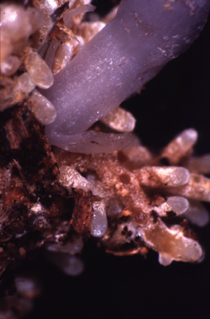Myco-heterotrophy


Myco-heterotrophy is a relationship between certain plants and fungi. The plant gets all or part of its food from parasitism on fungi, not from photosynthesis.
In the past, non-photosynthetic plants were thought to get food by breaking down organic matter like fungi do. Such plants were therefore called "saprophytes". That was wrong. It is now known that no plant is physiologically capable of direct breakdown of organic matter.
To get food, non-photosynthetic plants engage in parasitism, by myco-heterotrophy or direct parasitism of other plants.[2][3]
The interface between the plant and fungal partners in this association is between the roots of the plant and the mycelium of the fungus. Myco-heterotrophy therefore closely resembles mycorrhiza, and is thought to have evolved from mycorrhiza.[2][4][5]
References
- ↑ Yang S. & D.H. Pfister 2006 (2006). "Monotropa uniflora plants of eastern Massachusetts form mycorrhizae with a diversity of russulacean fungi". Mycologia. 98 (4): 535–540. doi:10.3852/mycologia.98.4.535. PMID 17139846.
- ↑ 2.0 2.1 Bidartondo M.I. 2005. The evolutionary ecology of myco-heterotrophy. New Phytologist 167: 335–352. PMID 15998389.
- ↑ Leake J.R. 2005. Plants parasitic on fungi: unearthing the fungi in myco-heterotrophs and debunking the ‘saprophytic’ plant myth Archived 2012-03-14 at the Wayback Machine. Mycologist 19: 113–122. .
- ↑ Trudell S.A; Rygiewicz P.T. & Edmonds R.L. 2003. Nitrogen and carbon stable isotope abundances support the myco-heterotrophic nature and host-specificity of certain achlorophyllous plants. Archived 2015-09-24 at the Wayback Machine New Phytologist 160: 391–401. .
- ↑ Bidartondo M.I. et al 2004. Changing partners in the dark: isotopic and molecular evidence of ectomycorrhizal liaisons between forest orchids and trees. Proceedings of the Royal Society of London, series B. 271: 1799–1806. .